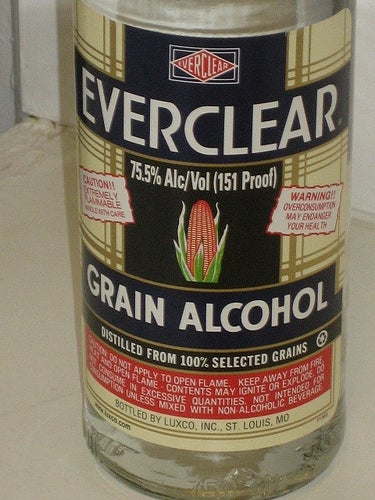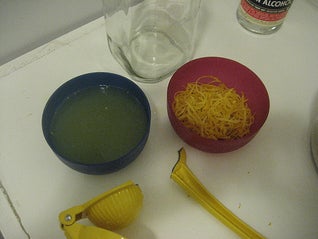Limoncello is a sweet, lemon-flavored Italian liqueur. Unlike many liqueurs, it’s very easy to make at home, requiring only the most basic of ingredients and tools. Doing so is easy but rewarding–from a scientific perspective for the chemistry involved in the process, and from a culinary perspective for the simple joy of drinking something you made from scratch.
One of the interesting things about limoncello is that it isn’t sour at all (if it’s made properly). This is because there’s no lemon juice in it. The lemon flavor comes from lemon zest–the very outside of the lemon peel, where the essential oils are most concentrated.
In its native Italy, limoncello is most frequently taken cold, as a digestif (an after-dinner drink). I find it especially refreshing early in the evening on a hot day, but it’s enjoyable any time you like.
Step 1: Overview


So, how do you make this wonderful stuff? The ingredients are as follows:
1 750 mL bottle of grain alcohol ( Everclear or similar, also known as rectified spirit–as long as it’s potable, strong, and unflavored you’ll be fine)
Zest of 8 lemons
Sugar
Water
Simple, yes? Oh, you’ll also need a glass jar in which to keep the stuff. Be sure you have lots of spare room, as you’ll add more liquid later. Mine is two liters, and works great.
You want to get the strongest alcohol you can get your hands on. Vodka, even the 100 proof stuff, isn’t sufficient. In some states, such as Nevada, you can get 190-proof Everclear, which is 95% ethyl alcohol. Alas, California isn’t one of them, so I’ll make do with 151 proof (75.5% alcohol, which is still pretty stiff). You can as well, but go with the high-test if you get it. You’ll dilute it down to something drinkable later; right now we need a strong but potable nonpolar solvent, and high-proof alcohol fits the bill. I understand an old catalog came with a disclaimer that Everclear was to be used “for the production of homemade cordials,” or some such, which is exactly what you’re doing here.
Step 2: Prepare the Lemon Zest



First, wash the lemons thoroughly. A produce brush helps a lot with this. Some folks use a special-purpose fruit and vegetable wash solution to get them super-clean, but I’ve never been one for such luxuries.
Next, zest the lemons. For those of you who aren’t familiar with the process, lemon peel consists of two layers: zest and pith. The pith is the inner, white part, and the zest is the outer, yellow part. You only want the zest, because the pith is bitter and will impart that bitterness to your limoncello. Therefore, be careful that you don’t get any bits of white in your zest.
There are a lot of ways to zest lemons. Going from low-tech to high, they’re as follows:
A knife. You can zest lemons with a knife, but it needs to be small and very sharp, and you need to be careful with it. Blood in your limoncello is not cool, no matter how much of a goth you are.
A potato peeler. Some people like these, but they probably have sharper potato peelers than I do. The first time I made this stuff, I tried this but then switched to a (just-sharpened) knife. Then I bought . . .
A lemon zester. Mine’s a knock-off of a nice ergonomic model from Zyliss and also includes a channel knife so you can make twists too.
A Microplane or similar fine grater. This might be the ultimate zesting tool–I’ve heard people say they make it much easier, and they certainly look like they would, but I don’t have enough use for one to justify dropping $15 or $20 on it. (Edit: On the recommendation of nattles, below, I have purchased a Microplane grating rasp, and it is everything a grater should be. Strongly recommended.)
Keep in mind that smaller bits of zest will give you more surface area, and therefore more chance for the lemon oils to dissolve into the alcohol. Knives and potato peelers will each give you little chips of zest, whereas the zester will give you thin strips, and the Microplane very tiny shreds. I’d go for the lemon zester if you didn’t have anything more specialized; it should only cost five bucks or thereabouts. Or if you want to splash out a bit more, get a Microplane rasp.
Step 3: Add the Alcohol and Wait


Next, pour the alcohol over the zest and wait a month or so. Keep the jar in a cool, dark place, and shake it every so often to mix the lemon zest around. In the meantime, maybe you could make lemonade or lemon chicken or something with all the lemons you have. Be advised that they’ll spoil much sooner without their zest, so you’d better get to juicing pretty quickly.
Step 4: Remove the Lemon Zest


2 More Images
OK! It’s been a month or so, and the alcohol has taken on a very bright yellow color. This is just what we want–it shows us that the lemon oils have left the zest and entered the liquid. Now it’s time to take out the lemon zest. If it’s done, the booze should be lemony and the zest very pale and somewhat more brittle. This is about right.
Step 5: Dilute, Sweeten, and Enjoy!


Remember when I said we’d dilute it down to something more reasonable? Now’s the time. I used 4 cups of water and 2-1/2 of sugar, which is a decent starting point. You may want to add a bit more sugar-water if you used the high-test Nevada Everclear instead of the weak stuff we get here in the California Republic, but it’s easy enough to adjust the strength later. (Edit: I have a batch in now that I’m planning on preparing according to Alain80’s recommendation below of a 1:1:1: ratio of alcohol to water to sugar (one gram of sugar per one milliliter of water/alcohol). I’ll post my results here once it’s done.)
Anyway, heat the water on the stove and stir in the sugar. You don’t need to boil the water, but you do need to get it hot enough so the sugar dissolves. Stir it frequently until it turns clear. The sugar-water will be markedly more refractive than plain water, because of all the dissolved sugar, but you should be able to see the bottom of the pan clearly.
There’s an argument that I should have taken pictures of making the syrup for completeness, but dissolving white powder in clear liquid to make another clear liquid is the sort of thing even the dimmest Photo 102 student would recognize as “not visually interesting.” My pedantic side demanded one, though, so it’s in this batch as well.
In any event, that’s it! You can drink it as it is, but it’ll improve with a month or so of sitting. It won’t freeze unless you added a lot of water, so feel free to keep it in the freezer. Good luck!

